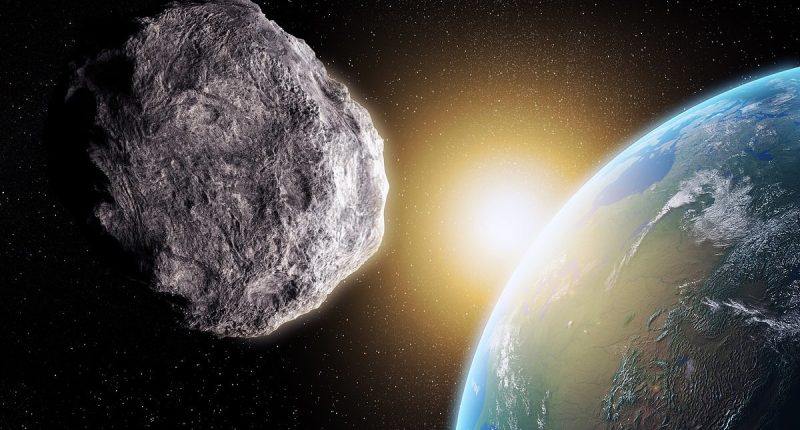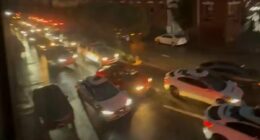Share this @internewscast.com
At least three city-killing asteroids that could strike Earth are hiding behind our closest neighbor in the solar system.
A recent study highlights that Venus is obstructing our ability to detect numerous near-Earth asteroids — large space rocks that come close to or intersect Earth’s trajectory — which could lead to a catastrophic collision.
Scientists from Brazil, France, and Italy have discovered that several asteroids moving in line with Venus’s orbit are very difficult to observe as the Sun’s glare often conceals them.
Three in particular, 2020 SB, 524522, and 2020 CL1, have orbits that take these asteroids dangerously close to Earth.
Moreover, these asteroids do not maintain consistently stable orbits, meaning any gravitational alterations could alter their paths, potentially steering them toward Earth.
The three asteroids flying along with Venus measure between 330 and 1,300 feet in diameter, making each one capable of leveling entire cities and setting off massive fires and tsunamis.
The researchers noted that the Rubin Observatory in Chile might be able to spot deadly asteroids approaching from our blind spot near Venus, but the window to see them would be extremely short, possibly lasting only two to four weeks.
If one of these asteroids were to hit a city, it would make a crater over two miles wide and release over one million times more energy than the nuclear bomb dropped on Hiroshima, Japan in 1945.

At least three city-killing asteroids that could strike Earth have been discovered near our closest neighbor in the solar system – Venus (Stock Image)

Most of the solar system’s asteroids are in the main belt between Mars and Jupiter. However, others are co-orbital with planets. Astronomers are now finding more of these asteroids co-orbiting with Venus, posing a threat to Earth
The international team, led by Valerio Carruba of São Paolo University, focused on asteroids that share Venus’s orbit around the Sun, called Venus co-orbital asteroids.
‘Twenty co-orbital asteroids of Venus are currently known,’ the authors wrote in their report to the journal Astronomy and Astrophysics.
‘Co-orbital status protects these asteroids from close approaches to Venus, but it does not protect them from encountering Earth,’ they warned.
Essentially, these asteroids are like dancers moving in step with Venus as they both move around the Sun; staying safely away from it due to their synchronized orbits.
However, their wobbly and unpredictable paths can cross Earth’s track, and if they reach that crossing point at the same time as Earth, they could crash into us.
The near-Earth asteroids 2020 SB, 524522, and 2020 CL1 are the most concerning because each has a very small Minimum Orbital Intersection Distance (MOID) – the closest distance between their orbit and Earth’s orbit around the Sun.
A smaller MOID means an asteroid’s chance of colliding with Earth increases dramatically.
These three asteroids near Venus have MOIDs of less than 0.0005 astronomical units (AU), which is about 46,600 miles – closer than the Moon’s average distance from Earth.
In April, scientists at NASA increased the chance of an asteroid hitting the Moon to four percent. That prediction came after the probability of an impact on Earth rose to 3.1 percent – the highest odds ever recorded for a large asteroid.

Researchers warned that they might be able to spot deadly asteroids approaching from our blind spot near Venus, but the window to see them would be extremely short, possibly lasting only 2 to 4 weeks
Since telescopes here on Earth have a limited ability to see in all directions out in space, the researchers believe that a dedicated space probe needs to be launched towards Venus.
According to their report, this is the only thing that can fully map the ‘still invisible’ hazardous asteroids hiding in Earth’s blind spot.
In February, NASA ruled out the possibility that another asteroid known as 2024 YR4 striking Earth in 2032.
The threatening space rock is around 200 feet in diameter and still has a 1-in-25 chance of colliding with the Moon.
Were it to hit the Earth, it would unleash a blast at least 500 times more powerful than that of the atomic bomb dropped on Hiroshima.
Despite moving out of the danger zone, scientists are still tracking 2024 YR4 to learn its exact size of composition.
If 2024 YR4 does hit the Moon in seven years, knowing these key facts could be a major boon for scientists around the world.
The blast wouldn’t affect Earth but it would be the first time scientists could watch a known asteroid create a lunar crater in real-time.
The data gathered from this impact could help scientists understand more about other craters on the lunar surface.
















